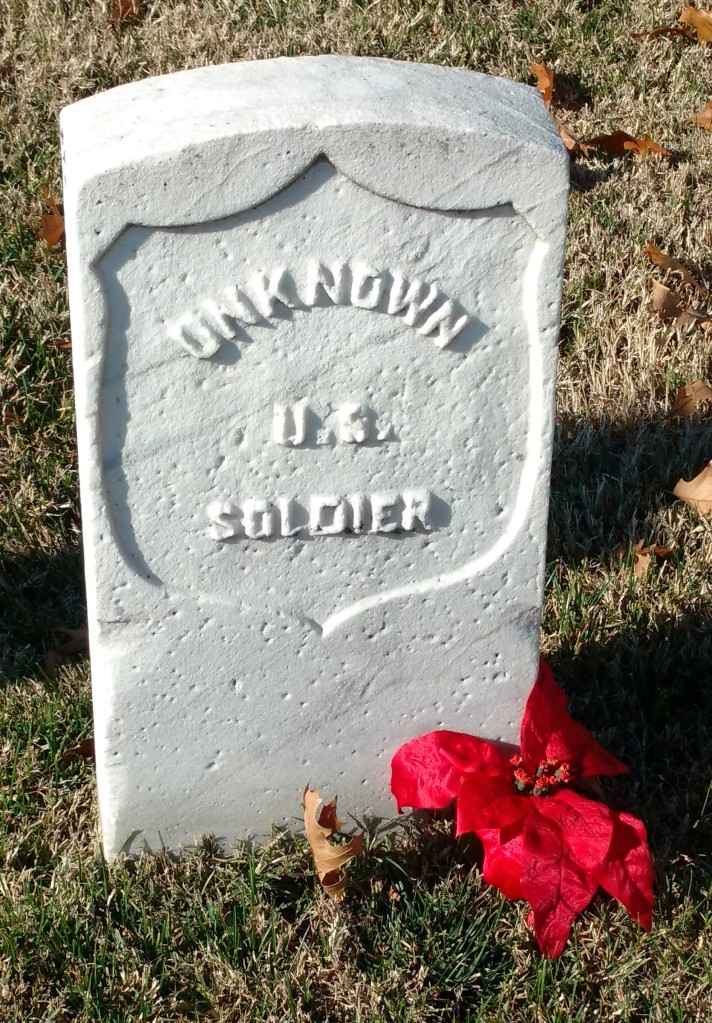A calm breeze carries through wide, green, rolling hills. Blades of grass slightly bend as the fallen leaves rustle about on the ground. A handful swirl about, settling against a granite headstone and obscuring the epitaph. The words read: ‘Unknown – U.S. Soldier’ stamped in the shield relief. Stepping back from the marker, what comes into view is an entire field of unknown soldiers. They are not alone however. They are in the company of others who served honorably in the armed forces.

The United States has an elaborate burial system for veterans and their families. The Department of Veterans Affairs (VA), National Cemetery System, Arlington National Cemetery, the U.S. Soldiers’ and Airmens’ Cemetery, the American Battle Monuments Commission, and various cemeteries under the jurisdiction of the National Park Service all comprise the different methods for interring deceased service members. During the American Civil War as private cemeteries were unable to accommodate the increasing number of Union dead, Congress passed legislation authorizing the creation of national cemeteries. Quartermaster General Montgomery Meigs, who lost his son Lt. John Meigs, was pivotal in choosing locations. What resulted was arguably the most famous cemetery in the world. Robert E. Lee’s home, Arlington House, was occupied by the Union within weeks of the war’s opening. Generals used the mansion as a headquarters for three years and in June 1864, Meigs ordered the burial of soldiers in the Arlington grounds. Meigs heavily resented Lee joining the Confederacy and historians argue there were political motivations for establishing a cemetery on his property. Union soldiers were buried and monuments were erected in later years, rendering the mansion unlivable. The government originally purchased the land in an estate sale due to delinquent property taxes, but the Lee family argued that the tax sale was improper. In the 1882 Supreme Court case, United States vs. Lee, the court ruled in favor of the Lees and returned the grounds. The victory was short-lived however since the family never occupied the house again and sold the property back to the government for a large sum. Today, Arlington National Cemetery is maintained solely by the U.S. Army, along with the Soldiers’ and Airmen’s Cemetery.

Following both world wars, the VA worked diligently to implement an administrative system that oversaw the maintenance of military cemeteries. In 1973, administration of military cemeteries passed from the Department of Defense to the VA and they established the National Cemetery System. The NCS comprises of 147 military cemeteries, with 131 under the jurisdiction of the Veterans Administration. Another 14 of these are controlled by the National Park Service (the majority of which are battlefields). While the most famous is Arlington; Jefferson Barracks, Fayetteville, Fort Leavenworth, Quantico, and the National Memorial Cemetery of the Pacific all protect the remains of our deceased veterans. Veterans can interred at any active location (active defined as functioning and eligible for burials meeting environmental standards). Sites under the jurisdiction of the NPS are typically connected to Revolutionary War, Civil War, and Indian War battlefields and are preserved for historical purposes. These include ones like Gettysburg, Andersonville, Little Bighorn, and Yorktown. Modern veterans are not buried at these sites dues to environmental damage that affected any historical preservation efforts.

U.S. service members are buried not only in the continental U.S., but overseas as well. The American Battle Monuments Commission administers and operates military cemeteries in countries like France, Belgium, Philippines, Italy, Luxembourg, and Panama. This independent government agency is responsible for maintaining overseas cemeteries and their activities such as wreath, remembrance, and memorial ceremonies. A handful were established as temporary cemeteries during wartime (i.e. Normandy), but many were converted into permanent locations through partnerships with the host country. The AMBC administers these sites, but the physical territory remains under the jurisdiction of the host country.

So how does a veteran become eligible for burial in a military cemetery? The basic criteria stipulates that a veteran must not have received a bad character of service discharge and provide the required paperwork (DD Form 214, Notice of Separation). A veteran who is killed while on active duty, especially in combat, are guaranteed a burial. National Guard and Reserve members must meet time-specific requirements or been mobilized at any point. What disqualifies a veteran from a military burial would be any of the following:
- Other than honorable discharge and lower; i.e. bad conduct or dishonorable.
- Convicted of capital crimes (murder, rape, child pornography, terrorism, etc.)
- Convicted of sex crimes
- Engaged in subversive activities against the United States
- Enlisted but never served (referred to as an Uncharacterized Entry Level Separation)
For more information on military burials, visit the VA Burials and Memorials Page.
These cemeteries are solemn, sacred places. Their symbolic value lies in with the soldiers who died serving the nation and are remembered for their deeds. As President Abraham Lincoln stated in his Gettysburg Address:
“But, in a larger sense, we can not dedicate — we can not consecrate — we can not hallow — this ground. The brave men, living and dead, who struggled here, have consecrated it, far above our poor power to add or detract. The world will little note, nor long remember what we say here, but it can never forget what they did here.”
These cemeteries and the memorials built to honor the past and living memory of the deceased and the conflicts are in many ways immortal. People can come and go, but the names are etched, stamped, and emblazoned for eternity in hallowed grounds around the world.